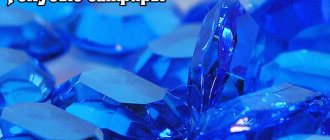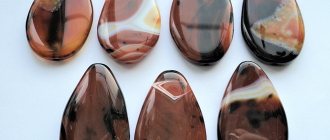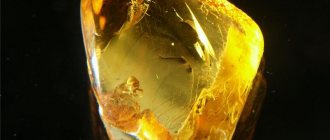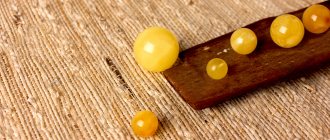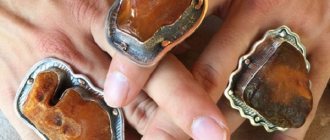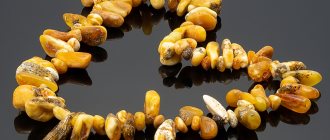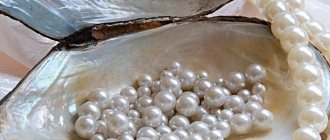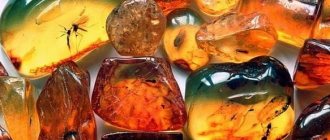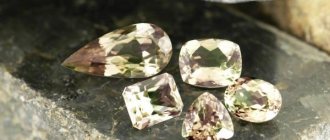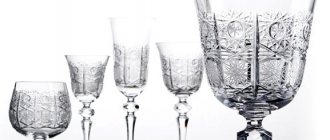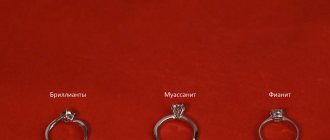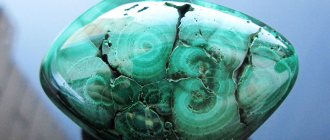Because amber has a number of unique characteristics, there are several different tests that can be used to determine whether it is real or not. People want to be sure that they are buying jewelry made from real Baltic amber, because other types of stone and fakes do not contain succinic acid, which determines the health benefits of such jewelry. The most common methods for testing this natural resin are listed below.
Visual inspection of amber
The first thing you can do when checking amber and jewelry made from it is to examine it visually. Real amber beads tend to have a unique appearance, so inspection is limited to looking for imperfections, which include tiny cracks and air bubbles. In addition, the beads should vary slightly in size and do not have to be round in shape. Amber is usually slightly warm to the touch, unlike most fakes.
Appearance
Natural amber has a transparent, uniform color with small inclusions. The color of natural stone is much darker than that of artificial stone. Noticeable uniform multiple inclusions of air bubbles throughout the entire area of amber indicate a fake. The inclusion of plant or animal remains in amber does not guarantee the authenticity of the stone. Real amber cannot be of the correct shape and have a bright shine. Natural amber, especially old amber, has micro chips.
Damage in the form of cracks and chips is a sign of real stone.
A fake made of plastic or glass has a porous structure from casting. There are no chips on the surface of artificial amber. There should be no seams on natural amber. The seams on the amber beads indicate a plastic fake.
Salt water test
Another effective test to distinguish real from fake amber is the salt water test. To carry it out you will need about 7 teaspoons of salt and a medium cup of water. Add all this salt to the water and mix well until completely dissolved. Then place the amber stone in the water. Real amber should float easily in it, while most fakes will quickly sink. The main disadvantage of this method is that it is not very suitable for testing jewelry containing metal or other elements. However, it works well on individual pebbles.
Authenticity tests at home
At home, you can carry out several tests that will help you distinguish a fake with a greater degree of reliability. However, some of them can damage the stone.
It should be borne in mind that the physical properties of amber may coincide with resins, so one test will not be enough. It is advisable to carry out several checks and take other indicators into account. Sometimes it is possible to distinguish imitation only in laboratory conditions.
Using salt water
The method is used only if the stone does not have a frame. Most samples have low density, so they float in salt water. To carry out the test, prepare a solution of 8 tsp. salt and 200 ml of liquid.
The spice is completely dissolved in water, then the stone is lowered. Crafts made from bakelite, burnite and glass sink, while amber most often floats. If the mineral is large, take a large container and add as much salt as the water will take.
The test is not considered completely reliable. Some specimens are quite dense, so they sink even in salt water. The lightest samples float in tap liquid.
Real amber will float in salt water.
Electrification
Natural stone is highly susceptible to electrification. For this test you will need a piece of wool or silk. The mineral is rubbed hard against the cloth, then brought to the paper. Natural stone immediately attracts the material to itself.
Using this method, amber is distinguished from copal. It does not become electrified even with prolonged exposure. Plastic can also attract paper, but this ability is less pronounced. To distinguish it from a real mineral, you will need a verified sample or visual inspection.
Natural amber is highly electrified.
Smell when melting
The mineral does not have to be melted. You can rub it hard against your palm to raise the temperature of the stone. In this case, the natural mineral will have a light pine aroma.
The fake resin smells even without exposure to high temperatures. Copal imitations begin to adhere to the skin after heating. Glass fakes have no aroma. Plastic can smell bad.
Additionally, you can bring the product to the fire. Use, for example, a lighter. When it comes into contact with a flame, the natural material will begin to boil and ignite. Black smoke will appear.
Counterfeits are either insensitive to fire or melt much faster. However, this is a traumatic method that will ruin the decoration. An alternative is to use a hot needle.
It will also damage the surface, but the defect will be less pronounced. Upon contact, white smoke should emit from the natural stone and a resinous odor will appear.
Amber is subject to combustion.
Solvent test
Natural stone is more resistant to solvents. As the latter, you can use, for example, acetone. Soak a cotton pad in the liquid and apply it to the surface for 1-2 seconds.
You cannot keep the stone in the solvent for more than 3-5 seconds, as this will ruin its appearance. With short-term exposure, amber remains the same and does not change.
Imitations made from copal deteriorate greatly, their surface becomes dull, and irregularities appear. The color changes. When pressed amber comes into contact with a solvent, it becomes sticky.
Alcohol
Alcohol is used in the same way as a solvent. Some stones are resistant to acetone, but are destroyed when exposed to ethyl alcohol. Other minerals, on the contrary, are resistant to the latter reagent.
Chemical reagents
Alcohol and acetone belong to the list of chemical reagents. Additionally, you can use stearin or ethers. They greatly change the appearance and tactile sensations when interacting with stones.
The mineral may, for example, become cloudy. But the abuse of chemical reagents can also spoil the amber itself, so reagents are used with caution.
Testing with chemical reagents must be carried out with care so as not to damage the stone.
Friction test
One of the easiest ways to distinguish amber from copal is to perform a friction test. Because real amber has electrostatic properties, it can attract tiny pieces of paper and dust particles when sufficiently charged. To charge amber, wrap it in a cloth and rub it for a while (20-60 seconds). After this, bring the stone to a strand of hair. If the hair is attracted to it, then static electricity has formed, and you most likely have real amber in your hands. Conversely, if the stone did not charge, but rather became sticky, it means it was dug.
Properties and characteristics of the stone
The properties and characteristics of natural amber are reflected in the table.
| Color | Shine | Stroke color | Transparency | Hardness | Cleavage | Kink | Density | Refractive index of light | Melting temperature |
| Varies from light light yellow to dark brown, with admixtures of red and green, and almost colorless and white varieties. | Smolyanoy | White | Varies from almost completely transparent to opaque | 2-2.5 points; soft material, scratches even with nails if you apply force | Absent | In relatively young samples it is viscous and conchoidal; in older specimens it becomes fragile | May vary: average - 1.05-1.09 per cubic meter. cm, but there are samples with a density of up to 1.3 g per cubic meter. cm | 1,54 | Reaches +350…+380 °C |
Hot needle test
Another way to distinguish real from fake amber is a hot needle test. To perform this test, you heat a needle and press it onto the stone. If the needle only went in a little or left cracks, you are most likely looking at real amber. Additionally, if the amber is real, you should also smell old rotten wood. When carrying out the same procedure with fakes, the needle enters very easily, and the smell of plastic or fresh pine (copal) appears. The main disadvantage of this test is that it may leave a small mark due to burning.
Methods of counterfeiting
Materials used in the production of artificial amber products:
| Resin | Slight deformation from slight finger pressure. Homogeneous structure. There are no bubbles or inclusions. Persistent light pine scent. |
| Ambroid (pressed amber) | It is waste from the production of amber jewelry. Essentially it is amber, but of a low grade; products are several times cheaper than those made from solid amber. |
| dug | Resin from evergreen trees. Experts and jewelers consider copal to be the “younger brother of amber.” The surface of the artificial stone has many cracks. The main difference between copal is that it produces a pleasant pine aroma without heating. |
| Glass | Differs in hardness. The glass is almost impossible to scratch; there are no chips or cracks on the products. |
| Plastic, acrylic, plexiglass | Plastic products are 100% similar in appearance, but are lighter than amber, have a different density, uniform color and structure. |
Amber: what does it consist of and what are its properties?
Amber is a resin that hardened millions of years ago.
It resembles honey in color. Therefore, our ancestors believed that the stone actually consists of frozen honey. People attributed protective and healing properties to the stone. It was worn as a talisman and people consulted with it on important issues. The healing properties of amber have been confirmed by scientific research. First of all, it helps women during pregnancy and breastfeeding. The main healing property of amber is to have a positive effect on a person at the energy level. Those who constantly carry this stone with them increase their resistance to stress and improve their overall well-being.
Amber is not just decoration. It's practically a way of life. Therefore, it is very important to buy real amber and not fakes.
Today, the raw materials for the latter are quite diverse. Starting from artificial materials - glass, plastic, bakelite and ending with natural sources - resins of various trees, copal - young amber, burnite and pressed amber.
Materials
An artificial gem is made from the following components:
- natural (resins of non-coniferous trees - legumes, cherries, pressed amber chips);
- synthetic (glass, epoxy resin).
Resin
To make imitations, resins from non-coniferous trees or polymer synthetic compounds are used. Used:
- The resin of plants from the legume group, for example, acacia and araucaria - copal. A dry insect is often placed there, with its legs and wings spread out for plausibility.
- Mixing resin (fresh resin secreted by the tree) with acetone and polystyrene foam or rosin and shellac in certain proportions.
- A mixture of epoxy resin, rosin and shellac.
Glass
Transparent imitations of amber are obtained from glass. Thanks to dyes, the color of the product can be any. This type of counterfeit is easier to spot than counterfeits made from other materials. You can determine the artificial nature of a stone using the following:
- glass shine;
- resistance to external damage and chemicals;
- high melting point (from 750 °C).
Pressed amber
Crumbs of amber, obtained during the production of jewelry and during the extraction of stones, are heated and pressed, giving the product the desired shape. The composition of ambroid (pressed amber) is identical to the original, but differs in quality characteristics.
You can distinguish a fake by its characteristics:
- opaque;
- does not contain inclusions;
- no air bubbles.
Unconventional ways to authenticate amber that can ruin its beauty
Amber is harder than copal, but softer than glass, and if you run a needle across the surface of the material, a scratch will definitely remain on the amber, but not on glass, whereas copal can be easily scratched even with a fingernail. However, it is not recommended to scratch amber beads with a needle if you plan to subsequently sell the amber, because any defect will reduce its value.
On the Internet you can find advice to run a sharp knife across the stone. It is believed that using this barbaric method you can accurately identify natural stone, which will immediately begin to crumble, and shavings will appear on a plastic product from under the knife. This is true, but you still shouldn’t spoil the beautiful stone that nature created over 100 million years.
There are brave souls who test the authenticity of a stone with fire, placing it over a gas burner or frying it in a hot frying pan. Yes, they will certainly see the result, since real amber burns with a large flame, emitting a pleasant aroma of incense, the smell of copal is reminiscent of medicine, and all types of plastics smoke and smell of burnt rubber. It’s scary to imagine what will happen to amber, every gram of which is worth its weight in gold!
Types of amber and their features
Today, more than 200 types of mineral are found. The most famous and popular stones include:
- Succinite is Baltic amber. It accounts for more than 95% of all stones that come to the market. The remaining species are considered amber-like. Such crystals can be yellow, red, orange. White specimens are also found.
- Gedanite - low oxygen content makes this type of amber very fragile. The gem is characterized by a waxy yellow tint.
- Glessite is a mineral with an opaque structure. It can be red, black, dark brown. Glessites practically do not include foreign components.
- Stanthienite - this type of amber is considered very fragile. It is characterized by a dark brown color.
- Bokkerite - this durable mineral has a dark brown tint. It is also characterized by a matte texture.
- Kiscellite - this type of mineral has a yellow or greenish color.
- Schraufit - the crystal has a bright red or slightly yellowish tint.
